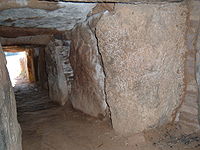
Klekkende Høj
Encyclopedia

Møn
-Location:Møn is located just off the south-eastern tip of Zealand from which it is separated by the waters of the Hølen strait between Kalvehave and the island of Nyord, at the northern end of Møn. Further south is Stege Bugt...
in Denmark
Denmark
Denmark is a Scandinavian country in Northern Europe. The countries of Denmark and Greenland, as well as the Faroe Islands, constitute the Kingdom of Denmark . It is the southernmost of the Nordic countries, southwest of Sweden and south of Norway, and bordered to the south by Germany. Denmark...
. It takes its name near the village of Klekkende. Høj, from the Old Norse
Old Norse
Old Norse is a North Germanic language that was spoken by inhabitants of Scandinavia and inhabitants of their overseas settlements during the Viking Age, until about 1300....
word haugr, means hill, mound or barrow.
Burial mound
The tomb is believed to date from the Neolithic Age, ca. 4500 years old, and is one of the best preserved of more than 100 burial mounds on the island. It is situated a short distance from the road between Tostenæs and Røddinge. The tomb is a passage gravePassage grave
thumb|250px|right|A simple passage tomb in [[Carrowmore]] near [[Sligo]] in IrelandA passage grave or passage tomb consists of a narrow passage made of large stones and one or multiple burial chambers covered in earth or stone. Megaliths are usually used in the construction of passage tombs, which...
, which means that the central chamber within the mound is reached by a connecting passage. Klekkende Høj is unusual in that there are two entrance passages running approximately parallel to each other, facing east. Within the mound is a central space running approximately north-south, which is divided through the centre by two large stones. One passage enters each half of the tomb. The entrance passages are approximately 7 metres long and sufficiently large for a crouching man. The central chambers are each approximately 4.5 metres long and larger, but not large enough for a man to stand. The chambers and passages are constructed from large stones set on edge, which support capstones laid flat across their tops. The whole was then covered by an earth mound.

Excavation
The tomb was excavated in 1797 by Antoine de Bosc de la Calmette, who was governor of the island. Fifteen men worked for a week to dig down into the tomb and remove some of the capstones so that the contents could be removed. Inside were a considerable number of human remains, flint weaponsFlint
Flint is a hard, sedimentary cryptocrystalline form of the mineral quartz, categorized as a variety of chert. It occurs chiefly as nodules and masses in sedimentary rocks, such as chalks and limestones. Inside the nodule, flint is usually dark grey, black, green, white, or brown in colour, and...
, clay vessels and amber
Amber
Amber is fossilized tree resin , which has been appreciated for its color and natural beauty since Neolithic times. Amber is used as an ingredient in perfumes, as a healing agent in folk medicine, and as jewelry. There are five classes of amber, defined on the basis of their chemical constituents...
jewellery. These were sent to the National Museum of Denmark
National Museum of Denmark
The National Museum of Denmark in Copenhagen is Denmark’s largest museum of cultural history, comprising the histories of Danish and foreign cultures, alike. The museum's main domicile is located a short distance from Strøget at the center of Copenhagen. It contains exhibits from around the world,...
in Copenhagen
Copenhagen
Copenhagen is the capital and largest city of Denmark, with an urban population of 1,199,224 and a metropolitan population of 1,930,260 . With the completion of the transnational Øresund Bridge in 2000, Copenhagen has become the centre of the increasingly integrating Øresund Region...
. The tomb was then re-sealed.


